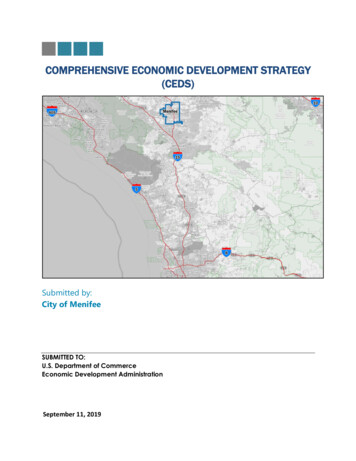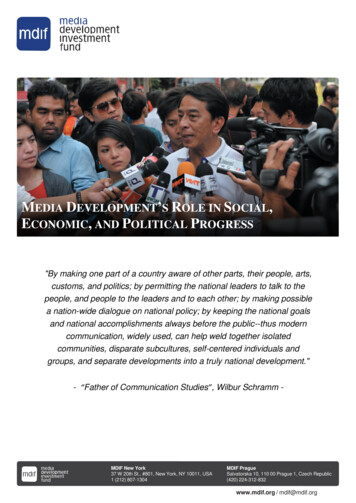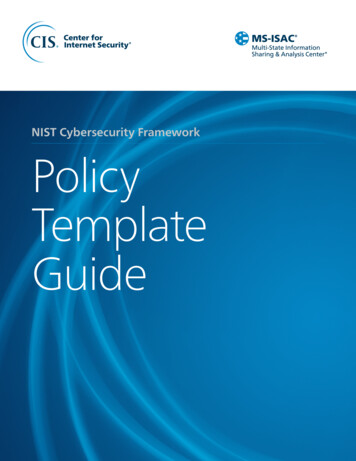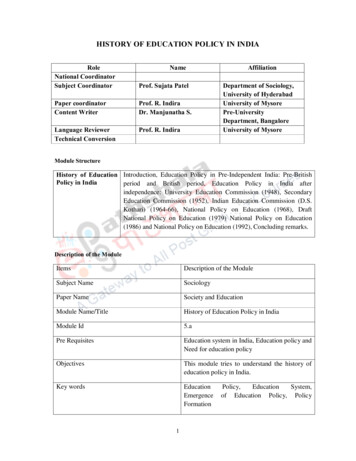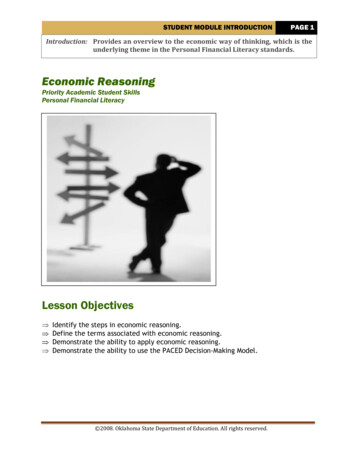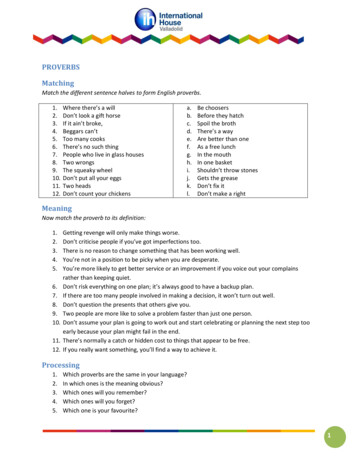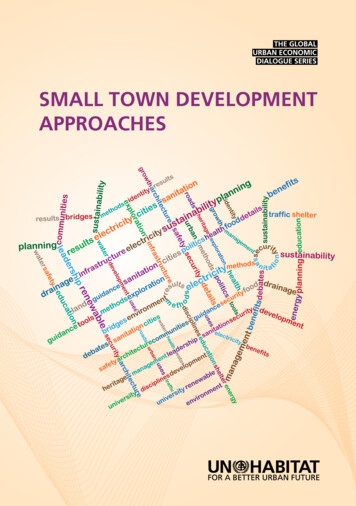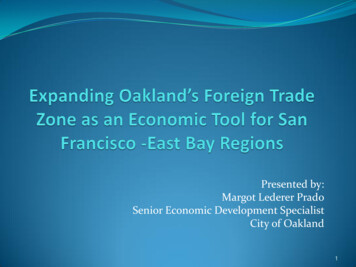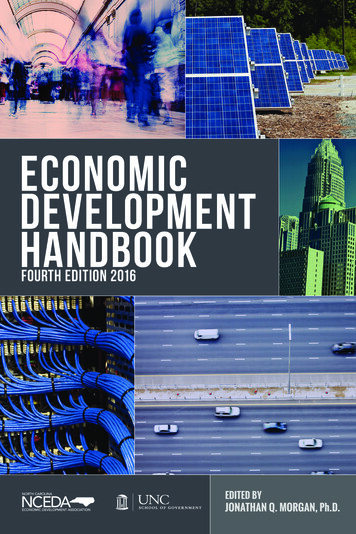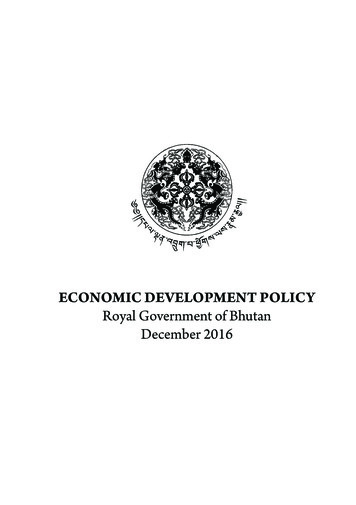
Transcription
Economic Development PolicyEconomic Development PolicyRoyal Government of BhutanDecember 2016 Royal Government of Bhutan December 2016 1
Economic Development Policy2 Royal Government of Bhutan December 2016
Economic Development Policy20162016intergenerational Royal Government of Bhutan December 2016 3
Economic Development Policy20164 Royal Government of Bhutan December 2016
Economic Development PolicyContents1. INTRODUCTION.12. OVERVIEW OF THE ECONOMY.32.1 Growth Performance.32.2 Changing Structure of the Economy.32.3 Public Finance.42.4 Economic Reforms.52.5 Positive Attitude.53. VISION.54. PURPOSE.55. A. OBJECTIVES.65. B. STRATEGIES.66. ECONOMIC OPPORTUNITIES.76.1 Brand Bhutan.76.2 Priority Sectors.8A. Five Jewels.8B. Other Sectors.97. POLICY REFORMS.107.1 General.107.2 Energy.15A. Hydropower.15B. Alternative Renewable Energy.187.3 Industrial Sector.19A. Industries Overall.19B. Cottage and Small Industries.207.4 Mining.227.5 Tourism.247.6 Agriculture.277.7 Construction.30 Royal Government of Bhutan December 2016 5
Economic Development Policy7.8 Education.337.9 Health.357.10 ICT.367.11 Trade.377.12 Financial services.407.13 Transport services.417.14 Water based industries.438. REVIEW OF THE REGULATORY FRAMEWORK.439. INCENTIVES.4410. THE WAY AHEAD.44Annex I: Prohibited List.456 Royal Government of Bhutan December 2016
Economic Development Policy1. INTRODUCTIONSince the commencement of planned socio-economic development, the countryhas progressed from the traditional stage to the precondition for economic takeoff. Various macroeconomic and human development indicators have witnessedimprovements over the years. In the first decade of the present century, the countrycontinued to experience acceleration in average annual growth rate of real GrossDomestic Product (GDP) to 8.53% from 5.9% in the 1990s. With a per capita incomeof US 2,611 as of 2014, Bhutan falls in the low middle income group.Planned development has brought about significant structural changes in theeconomy moving away from the primary sector towards secondary and tertiarysectors. The rapid growth and consequent structural changes have been driven bythe public sector through hydropower projects and financial support from donors.The occupational structure of the economy has however not, shifted in a mannerconsistent with the changes in the sectoral composition of GDP and is a disturbingtrend reflecting jobless growth.Bhutan’s economic development policy continues to be guided by the overarchingphilosophy of Gross National Happiness (GNH) based on the four pillars ofsustainable economic development; preservation and promotion of culture andtradition; conservation of environment; and good governance.However, sustainable economic growth continues to remain a major challenge. Theeconomic growth is largely financed by external aid. The current account deficit iswidening, balance of payment situation remains weak, public debt is mounting, andforeign exchange reserves are difficult to sustain through exports. In addition, theother constraints are:1)2)3)4)5)6)7)8)Small domestic market.Narrow export product base and markets.Inadequate infrastructure.High transportation cost.Difficult access to finance.Inconsistent policies/lack of coordination.Lack of management skills.Shortage of professionals. Royal Government of Bhutan December 2016 1
Economic Development Policy9) Low productivity of labour.10) Absence of R&D capability.11) Access to land.Despite the challenges, the country does have some very clear competitiveadvantages, which needs to be harnessed. These are:1)2)3)4)5)6)7)8)Political stability.Peace and security.A vibrant and living culture.Natural and pristine environment.Strategic geo-economic location with access to regional markets.Reliable and competitively priced energy.Nation of GNH.Wide use of English language.These advantages can be classified as the country’s Unique Selling Point (USP),one that builds on and will become Brand Bhutan. Once developed, Brand Bhutanwill be promoted as a standard for goods and services that ensure “GNH” elementsare maintained such as being clean, culturally sensitive and supportive, organic,community based etc.The Economic Development Policy (EDP) sets the agenda and the general directionfor the development of sectors that have the highest potential. This Policy departsfrom the usual sector/agency based approach and has been prepared in consultationwith a wide range of stakeholders from private to government and its success dependson an integrated and wholesome involvement of all the stakeholders. To accelerateeconomic growth, a clear, stable and transparent policy framework is necessary. Thedocument will also be accompanied by a set of incentive packages to boost growth.The Royal Government shall work towards achieving a minimum average economicgrowth rate of 10% and strive to be a middle-income nation by 2020.2 Royal Government of Bhutan December 2016
Economic Development Policy2. OVERVIEW OF THE ECONOMY2.1 Growth PerformanceThe economy has taken off to a higher growth trajectory since 1980 and has registereda long-term average annual real growth rate of 7% in the 30 years after 1980. Theaverage annual growth rate in the 1980s was 7.4%, which de-accelerated to 5.9% inthe 1990s, but accelerated again to 8.53% in the first decade of the present century.2.2 Changing Structure of the EconomyTable 1 examines the structural changes in terms of sector-wise contribution to GDP.The changes reflect that the economy has modernized as the share of the secondaryand tertiary sectors in the GDP has increased.Table 1: Sector-Wise Share in Real GDP (in %)Year19801990200020102015Primary SectorSecondary SectorTertiary .7841.3433.240.4241.99Table 2 provides an insight into the changes in the composition of different subsectors of GDP. In 2015, the 1) Construction 2) Agriculture 3) Electricity and Watersupply 4) Wholesale and Retail Trade 5) Transport, Storage and Communicationswere the top five contributors to GDP aside from manufacturing. Royal Government of Bhutan December 2016 3
Economic Development PolicyTable 2: Share of Select Sub-Sectors in Real GDP (%)YearAgricultureWholesale and RetailTradeTransport, Storage &CommunicationsCommunity, SocialServicesFinance, Insurance & RealEstateMining & QuarryingManufacturingElectricity, Water & GasConstructionHotels and Restaurants1980 1990 2000 2010 2013 2014 201527.8 15.4 12.7 16.8 16.10 16.77 2.3 Public FinanceThe domestic revenue was able to cover 100% of the recurrent expenditure and 25%of capital expenditure in 2014-15. However, external resources are required to coversubstantial part of capital expenditure. Public debt is rising with the debt to GDPratio at 96.5% as of June 2015 mainly contributed by financing for mega hydropowerprojects. Nevertheless, the public finance target in the 11 Five Year Plan is tomaintain an average fiscal deficit of 3% of GDP. Further, the Public Debt Policy 2016shall ensure that public debt stock is maintained at sustainable levels and the PublicPrivate Partnership Policy shall promote public private partnership to supplementpublic finances to achieve the objective of the EDP 2016.4 Royal Government of Bhutan December 2016
Economic Development Policy2.4 Economic ReformsThe Economic Development Policy encompasses major economic reforms includingthe restructuring of the macroeconomic base which will include the five jewels,namely hydropower, agriculture, cottage and small industries, tourism and mining.The specific areas among others include finance, construction, ICT, trade, industry,transport, education, health and other legislative initiatives.2.5 Positive AttitudeEconomic reforms lead not only to tangible benefits but also in changing the attitudesand work ethics of a society. Therefore, the Policy will seek to bring about a changein the attitude of the people. The promotion of a rational and scientific temperament,dignity of labour, spirit of adventure, entrepreneurship, creativity and innovationwith ethics and hard work are attitudes that are essential for the success of a marketbased economy. Policy makers and implementing agencies must lead by example andbe oriented towards problem solving and service delivery.Social transformation must accompany any industrial advancement that seeks to bejust, merit based, progressive and inclusive.3. VISIONA green and self-reliant economy sustained by a knowledge based society guided bythe philosophy of GNH.4. PurposeThe EDP shall provide the highest level of “strategic direction”, to ensure thateconomy takes the centre stage of development initiatives. The Policy recognizes thatunless the constraints to business growth are systematically addressed, the capacityof the private sector as the engine of growth cannot be enhanced. In this context, thePolicy aims at creating an enabling environment for investment.The EDP shall be the apex policy for economic development of the country andshall be the guiding document for all ministries and agencies to stimulate economic Royal Government of Bhutan December 2016 5
Economic Development Policygrowth and more importantly, to ensure that growth takes place in consonance withthe principles of GNH. This Policy provides the basis for government interventionto enhance productivity of the economy as a whole and wherever necessary, policies,laws, rules and regulations shall be harmonised or amended in line with the provisionsof the EDP.The time line to achieve the goals of this Policy shall be 2020.5. A. OBJECTIVES5.1 Achieve economic self-reliance by the year 2020.5.2 Sustain full employment (97.5%).5. B. STRATEGIES1.2.3.4.5.6.7.8.Promote the five Jewels.Diversify the economic base with minimal ecological footprint.Harness and add value to natural resources in a sustainable manner.Increase and diversify exports.Promote Bhutan as an organic brand.Promote industries that build the Brand Bhutan image.Reduce dependency on fossil fuel.Promote industries through a cluster effect and championingapproach.The economic development process shall take into account environment mainstreaming in a phased manner that allows for industries to grow as well as engage incleaner production. The success of the country’s environment conservation effortsshall be one of the main drivers for developing the “Brand Bhutan” theme. Protectionof biodiversity, genetic resources and promotion of indigenous knowledge shall bepursued.Bhutan’s commitment to remain carbon neutral contributes to developing the“Brand Bhutan” theme and will be pursued to capitalize on the opportunities arisingfrom the global trends towards low emission development while at the same timeleapfrogging towards global best practices.6 Royal Government of Bhutan December 2016
Economic Development Policy6. ECONOMIC OPPORTUNITIESA broad range of economic opportunities have been identified and these will be basedon developing the “Brand Bhutan” in natural resources, tourism, culture, handicrafts,textiles and agro produce. The other opportunities lie in building on the existingcomparative advantages of location, natural resource endowment and availability ofclean energy. The promotion of “Brand Bhutan” will be based on its USP.6.1 Brand BhutanBhutan is known as a nation that accords the highest priority to environmentalconservation, a nation whose constitution requires that at least 60% of the land areais maintained under forest cover for all times to come, a nation that has brought abouta paradigm shift in development theory by introducing the unique concept of GNH,a nation where tradition and culture still play an important role in the daily lives ofthe people. These will form the basis for Brand Bhutan and every effort will be madeto maintain this uniqueness.Brand Bhutan will not only be confined to the quality of the product but also reflectthe values of Bhutanese society, history and GNH philosophy. Brand Bhutan willpromote and support initiatives that lead to the betterment of society. To succeed,Brand Bhutan will communicate the unique values of Bhutan and how thedevelopment philosophy of GNH affects the way these products are produced anddelivered. Besides offering philosophical justifications, the products will adhere tothe highest quality standards as well as have functional value for buyers.Brand Bhutan will be sold through the story of Bhutan. This brand will be an umbrellabrand under which there will be sector brands to assist exporters in achievingthe targets and getting due recognition. The sector brands will be supported toconsistently meet standards, marketing and sales promotion and all these will belinked to enhancement of the quality of human resources in the country.Industrial products will have to comply with the highest manufacturing standards,services with the best standards that exist for hospitality, textile and handicrafts willbe promoted through the Bhutan SEAL and agro based products through fair tradeand organic certification. Royal Government of Bhutan December 2016 7
Economic Development PolicyPromotion of Brand Bhutan shall address both the supply side and demand sideand to do so will mean drawing on the resources that the country has to offer whileincorporating the preferences and taste of the consumers overseas. This for instancewould mean that the brightness of our textiles get sublimed in the sober colours thatthe affluent Western markets prefer or our paintings maintain the same details of thepast but are subtle in colour.The world knows about Bhutan but this does not mean it will buy Bhutan; BrandBhutan must create the demand for brands that consumers recognise and want tobuy.6.2 Priority SectorsBased on Bhutan’s USP, resource endowments, developmental focus and desiredoutcomes of economic development, the following sectors shall be treated as prioritygrowth areas. Among these, the Five Jewels constitute the core growth areas in termsof their potential and impact to the society at large.A.Five .k.l.HydropowerCottage and Small IndustriesMiningTourismAgricultureOrganic farmingAgro-processingBiotechnologyForest based productsPoultryFisheriesFloricultureHealth foodAnimal feedApicultureHorticultureDairy8 Royal Government of Bhutan December 2016
Economic Development PolicyB. Other Sectors6.2.66.2.76.2.86.2.9a.b.c.d.e.f.h.High Quality Green ServicesEducationHealth services and traditional medicinesICT (BPOs, KPOs, green data centres, software development, animation)Financial servicesR&DProfessional services andWaste Management Servicesa.b.EnergySolar and wind energyOther sources of renewable energya.b.c.d.e.f.Information, Media and Cultural IndustryFilm and Creative ArtsHandicraftsTextilesFine art including the performing artsPublishingFestivals, spiritual centres, etca.b.c.Transportation and Related ServicesGreen and non-fossil fuel based modes of transportationMass transportationRailways, rope ways, cable cars and riverine transport6.2.10 Constructiona. Mechanizationb. Green ectric vehicles and transportElectrical transformers, equipment, gadgets, fittingsComputer hardware Royal Government of Bhutan December 2016 9
Economic Development Policye.f.g.h.i.j.k.Building materialsPower intensive industriesPharmaceuticalsTraditional and herbal medicinesMineral processingWater based productsWood based industriesThe areas identified above are those that have the highest potential to generatewealth, employment and sustainable growth within the framework of GNH.Therefore, these will be the areas that will receive encouragement and support fromthe Royal Government. However, it does not mean that these will be the only areasthat the country can develop. Both the Royal Government and the private sectorshall continue to identify other opportunities.The southern region shall be promoted as the main economic hub for trade, transport,storage and manufacturing through creation of industrial estates, dry ports andSpecial Economic Zones. In the interior, focus will be on the promotion of services,cultural and high value products through CSI clusters.7. POLICY REFORMS7.1 GeneralCreating an enabling environment for businesses is a cross cutting issue and theRoyal Government shall adopt the following measures:7.1.1Access to Land7.1.1.1The relevant Government agencies responsible for promoting respectivesectors of the economy shall proactively identify land in collaborationwith the National Land Commission (NLC) and develop/facilitatedevelopment of infrastructure for growth of businesses.7.1.1.2Local Governments in collaboration with the NLC shall identifyindustrial areas within their respective jurisdictions by 2017 to facilitateestablishment of industrial and service activities.10 Royal Government of Bhutan December 2016
Economic Development Policy7.1.1.3The allotment of State Reserve Forest (SRF) land shall be prioritised onstrategic business activities such as large stand alone projects with clustereffects and public utility services.7.1.1.4The NLC shall prepare a national land use plan (Zoning) for SRF landwhich will outline use of land for optimal use by 2018. For this purpose,all relevant sectors shall provide sectoral parameters to NLC by 2017.7.1.2Ease of Doing Business7.1.2.1The Royal Government shall focus and continue its concerted efforts toimprove the ease of doing business and scale up its position within the top50 in the Doing Business Ranking.7.1.2.2Government agencies responsible for providing sector clearancesshall determine and adhere to the “turnaround time” for providing theclearances/licences by 2017.7.1.2.3Leveraging on IT enabled services, the Royal Government shall enhancethe delivery of public services and increase access of information throughinitiatives such as G2B, G2C, ePortal and iGuide. Each agency shall makeavailable online, procedures for seeking clearances/licenses, turnaroundtime, fees and levies among others.7.1.2.4One stop shop shall be introduced through the use of IT amonggovernment agencies responsible for providing clearances. The Ministry/Agency that is responsible for issuing the final approval/licence shall bethe only point of contact for the applicant.7.1.2.5The Royal Government shall adopt One Government principle wherebyall Government agencies shall function as one Government and shallnot seek repetitive documents. Required documentation submitted bya citizen or business to one government office shall suffice for all othergovernment agencies for the project concerned.7.1.2.6Private sector investment shall be allowed in all areas except those listedin the Prohibited List attached as Annexure I. Royal Government of Bhutan December 2016 11
Economic Development Policy7.1.3The burden of compliance shall be reduced by mandating all agencies toadopt the Licensing Policy by 2017.7.1.4Regulatory agencies shall increasingly adopt ex-post assessment andmonitoring along the principles of rewarding good behaviour andcompliance.7.1.5The Royal Government shall establish a dedicated institution whichcould be an existing institution with adequate funds by 2017 to promoteand support Research and Development (R&D).7.1.6The Royal Government shall pursue corporatization of its entitieswhere feasible and also outsource/privatise such functions which can bedelivered more efficiently and economically by private entrepreneurs.7.1.7Embassies and missions abroad shall be strengthened to play amore active role in economic diplomacy, multilateral and bilateraltrading arrangements. The Royal Government shall appoint Traderepresentatives/officials in all Embassies/Missions with clear Terms ofReference by 2017.7.1.8The Royal Government shall implement the Public Private Partnership(PPP) Policy by 2017 to facilitate public private partnership ininfrastructure projects.7.1.9The Royal Government shall adopt an Intellectual Policy by 2017. Thefocus of the Policy shall be to promote, support and protect innovationand creativity in the country. Laws, institutions and mechanisms for theimplementation of the policy shall be adopted and strengthened.7.1.10Appropriate, time bound and targeted incentives shall be provided for theJewels and identified priority sectors to promote and encourage economicgrowth.7.1.11In order to promote confidence to investors, the Royal Government mayconsider acceding to relevant international/UN conventions.12 Royal Government of Bhutan December 2016
Economic Development Policy7.1.12The Royal Government shall develop strategies and action plan forimplementation of Brand Bhutan.7.1.13Access to Foreign Exchange7.1.13.1The Royal Government shall provide foreign exchange for import of plantand machinery/equipments for licensed businesses.7.1.13.2The Royal Government shall provide foreign exchange for the paymentof fees, royalties for technology transfer and franchises and for expatriateprofessionals as approved.7.1.13.3The Royal Government shall provide foreign exchange for importingcritical secondary raw materials from third countries that constitute lessthan 15% of the value of direct inputs including electricity.7.1.13.4The Royal Government shall provide foreign exchange for payment ofinterest, charges and amortization on convertible currency or permittedforeign currency loans as approved by the Royal Government.7.1.13.5The Royal Government shall provide foreign exchange for repatriationof dividends as provided for in the FDI Policy 2010 and amendmentsthereto.7.1.13.6The Royal Government shall provide foreign exchange for trade andindustry as per rules in vogue.7.1.13.7The Royal Monetary Authority (RMA) shall review and revise theForeign Exchange Regulations 2013 by 2018 to incorporate the eligibilityand entitlement thereto for any foreign exchange requirements.7.1.14Human Resource Development & Employment7.1.14.1The Royal Government shall adopt and implement the Technical andVocational Education Policy and blueprint by 2017. Royal Government of Bhutan December 2016 13
Economic Development Policy7.1.14.2The Royal Government in collaboration with the private sector shallidentify critical skilled labour deficiency areas and support skillsdevelopment to address the needs of the labour market includingaddressing gender gaps in skills development, where necessary.7.1.14.3The Ministry of Labour and Human Resources (MoLHR) shall adoptand implement the National Work Force Plan by 2017.7.1.14.4The Royal Government shall establish an autonomous EntrepreneurshipDevelopment Institute by 2018 to promote entrepreneurship.7.1.14.5The Royal Government shall ensure that any foreign service providerwishing to participate in major works must engage local firms fortransfer of technology/skills. A framework specifying the level of localparticipation shall be developed by 2018.7.1.15The Royal Government shall adopt and implement the CompetitionPolicy by 2018.7.1.16The Royal Government shall review the regulations relating to thepossession of assets and properties outside Bhutan by Bhutanese citizensto promote investments abroad.7.1.17The Royal Government shall support the growth of domestic industriesthrough preferential public procurement by according ten percent marginof preference.7.1.18The Royal Government shall establish public sector projects in thoseareas where the private sector is unable to invest, manage or implement.The Royal Government shall divest non-strategic projects over a period oftime.7.1.19The Royal Government shall revise and adopt the national publicconsultation guidelines to address conflicts and ensure harmonizationunder different legislations.14 Royal Government of Bhutan December 2016
Economic Development Policy7.2 EnergyEnergy is the greatest opportunity for the country and the main driver of theeconomy. The availability of fast flowing rivers and the abundance of sunshine,biomass, wind etc. offer tremendous opportunities for hydropower and renewableenergy development, particularly in the light of concerns on global climate change.Most importantly, investing more in harnessing renewable and sustainable energy,especially hydropower energy, would not only boost sustainable and equitable socioeconomic development, it would also help in conserving environment. The energypolicy shall be aimed at accelerating the sustainable growth in the sector.A. HydropowerThe nation is well endowed with hydropower potential of 30,000 MW of which23,760 MW is techno-economically feasible. Hydropower is a strategic nationalresource and a main driver of economic growth, continuing to be among the largestrevenue generator accounting for 19% of the total revenue contribution in 2015-16.The development of this sector is key in achieving sustainable economic self-relianceand towards this, development of hydropower shall have a three pronged objectiveof i) meeting the nation’s domestic energy security, ii) promoting industrial growthand iii) enhancing revenue.Acknowledging the potential, the Royal Government has declared hydropower asone of the five jewels of economy. In this regard, the Royal Government shall striveto achieve a minimum power generation of 5000 MW by 2022. Efforts will alsobe made to build capacity towards becoming a knowledge centre for hydropowerdevelopment and related services both in the region and globally.The Policy framework for the development of hydropower sector shall be as follows:7.2.1The Royal Government shall provide electricity to all households.7.2.2Essential public institutions and services shall receive highest priority forsupply of electricity. An Electricity Allocation Policy shall be adopted by2018. Royal Government of Bhutan December 2016 15
Economic Development Policy7.2.3The development of hydropower shall be accelerated by promotingconstruction of projects and inter-linking of transmission grids to ensureenergy security and reliability and further integrate with regional grids topromote electricity trade.7.2.4Hydropower projects shall be developed in line with the BhutanSustainable Hydropower Policy (BSHDP) 2008 and amendmentsthereto.7.2.5The Royal Government shall continue to meet the growing domesticenergy requirements while taking advantage of export opportunities. Inorder to ensure national energy security through increased firm powercapacity, the development of storage hydroelectric projects shall beaccorded pr
philosophy of Gross National Happiness (GNH) based on the four pillars of sustainable economic development; preservation and promotion of culture and tradition; conservation of environment; and good governance. However, sustainable economic growth continues to remain a major challenge. The economic growth is largely financed by external aid.
